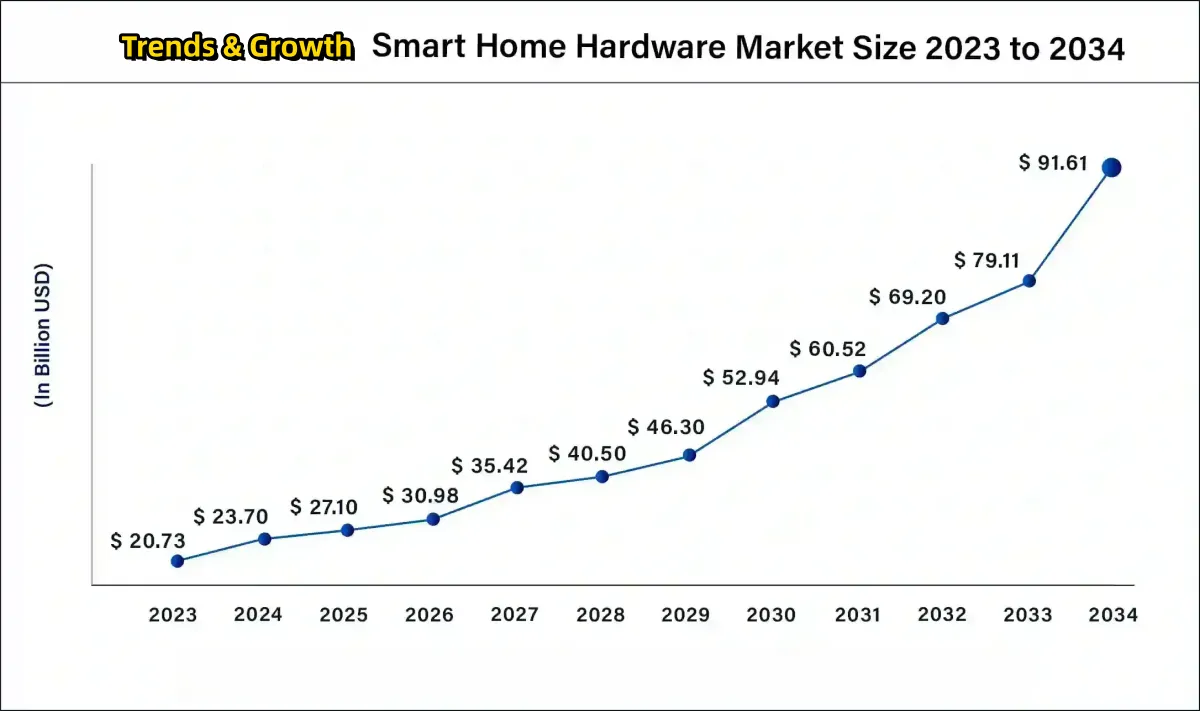
2024-2033 Smart Home Hardware Market Analysis: Key Trends and Growth Insights
According to a study published by Market.us research report published by Market.us, the global smart home hardware market size is expected to grow from $73.4 billion in 2023 to around $276.9 billion by 2033, growing at a CAGR of 14.2% during the forecast period of 2024 to 2033.
Smart home hardware refers to electronic devices and equipment designed to automate and control home functions. This includes smart speakers, security cameras, thermostats, and lighting systems that can be controlled remotely via a smartphone or voice assistant to improve convenience and energy efficiency.
The smart home hardware market includes producing and selling devices that support home automation. The market caters to the growing consumer demand for connected homes and offers products integrated with smart ecosystems. It includes devices for security, lighting, climate control, and entertainment.
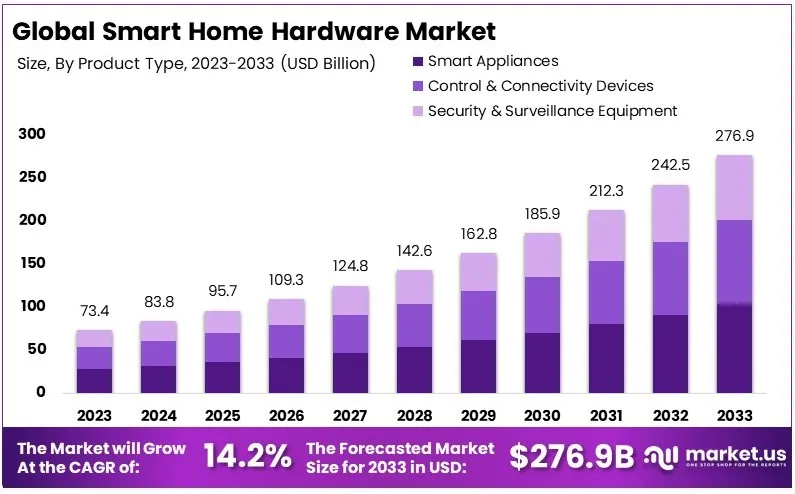
Global Smart Home Hardware Market Forecast
The smart home hardware industry is witnessing strong growth due to increased connectivity, expanding IoT adoption, and rising consumer spending on smart devices. Global 5G connections reached nearly 2 billion by Q1 2024, adding another 185 million in the quarter, reflecting the rapid expansion of 5G services globally.
The average U.S. household will have 17 connected devices in 2023, demonstrating the growing interest in home automation and connected ecosystems. Americans spend approximately $800 per household on connected devices, underscoring high consumer penetration and demand.
Smart home hardware market demand is driven by increasing urbanization and rising disposable income. The rate of urbanization has been increasing globally and is expected to add 2.5 billion people in urban areas by 2050, thereby increasing the demand for smart home solutions.
U.S. disposable personal income (DPI) increased by $34.2 billion to $21.78 trillion in August 2024, supporting increased consumer spending on connected home devices. These trends provide significant opportunities for the adoption of smart home hardware.
In developed markets such as the U.S. and Europe, the smart home hardware market is moderately to highly saturated due to the widespread adoption of connected devices. Low to moderate saturation in emerging markets indicates significant growth potential supported by accelerating urbanization and rising middle-class incomes.
The smart home hardware market is highly competitive, with multiple brands vying for market share through innovations such as AI integration, energy efficiency and enhanced safety features. Focus on affordability, seamless connectivity, and user-friendly interfaces to differentiate their products.
Government support for digital infrastructure, smart cities, and energy-efficient devices indirectly contributes to the growth of the smart home hardware market. Regulations focusing on data privacy, cybersecurity, and energy standards impact product design and compliance costs. However, these regulations drive innovation and create smarter, safer, and more energy-efficient devices.
Key point
- The smart home hardware market was valued at $73.4 billion in 2023 and is expected to reach $276.9 billion by 2033 at a CAGR of 14.2%.
- In 2023, intelligent appliances lead the product type with a 37.6% share due to consumer interest in home automation and energy efficiency.
- The residential segment will be the largest end-user by 2023, reflecting the growing popularity of smart home devices.
- North America accounted for 37.9% of the smart home hardware market share in 2023, driven by a strong consumer base for smart home products and technology integration.
Product Type Analysis
Smart home hardware product types include control and connectivity devices: smart hubs and controllers, lighting controls, smart lights, relays and switches, occupancy sensors, dimmers; entertainment devices: smart TVs, streaming media devices, smart speakers; smart appliances: smart thermostats, sensors, smart vents, smart kitchen appliances; security and surveillance devices: security cameras, video door phones, smart locks Motion Sensors, Door/Window Sensors …… and more.
Of these, smart appliances dominated the smart home hardware market with a 37.6% share as they are increasingly integrated into daily household activities.
The smart home appliances segment led the smart home hardware market by holding 37.6% of the market share. The dominance of this sub-segment is mainly attributed to the growing consumer demand for convenience, energy efficiency, and enhanced connectivity in the home environment.
Smart appliances, including smart refrigerators, dishwashers and cooking devices, provide users with unprecedented control over their home environments through advanced features such as remote monitoring, auto-tuning and energy consumption analysis.

Integrating AI and IoT technologies has enabled devices to learn from user behaviour and automate tasks accordingly, which has further fueled the segment’s growth. For instance, smart refrigerators can monitor food and recommend recipes based on available ingredients.
In contrast, the Control and Connected Devices subcomponent, which includes smart hubs, controllers, and sensors, facilitates the interoperability of various smart devices within the home, creating a cohesive and user-friendly ecosystem.
Entertainment devices such as smart TVs and smart speakers enrich the home entertainment experience by offering streaming and voice control capabilities, making them popular among consumers seeking leisure and convenience.
Finally, security and monitoring devices, including smart locks and cameras, provide homeowners with enhanced security features and peace of mind by allowing remote monitoring and control of their home security systems.
Technical analysis
Wi-Fi technology dominates the smart home hardware market, providing robust and reliable connectivity for smart home devices.
Wi-Fi technology is the primary method of enabling communication between smart home devices, facilitating seamless connectivity and high-speed data transfer within the smart home ecosystem. Its widespread adoption is due to its ability to support a large number of devices simultaneously and its compatibility with existing home networks.
The reliability and range of Wi-Fi networks enable users to operate their smart devices from anywhere in the home without interruption, which is critical to a smart home system’s functionality and user satisfaction.
Wi-Fi’s dominance in the marketplace is further cemented by continuous technological advances, such as the development of Wi-Fi 6, which offers faster speeds and more efficient data processing. This is especially important as homes become more connected and data exchanged between devices increases.
Bluetooth technology also supports direct device-to-device communication, which is critical for small, battery-powered devices where power efficiency is critical and plays an important role in the smart home hardware market. Zigbee and Z-Wave are uniquely positioned to create mesh networks that extend the range of smart home networks without additional power supplies.
The “Other” category includes technologies such as RFID and NFC that provide additional functionality to smart home devices, such as simplified setup processes and enhanced security features, contributing to the overall growth and diversification of the smart home technology sector.
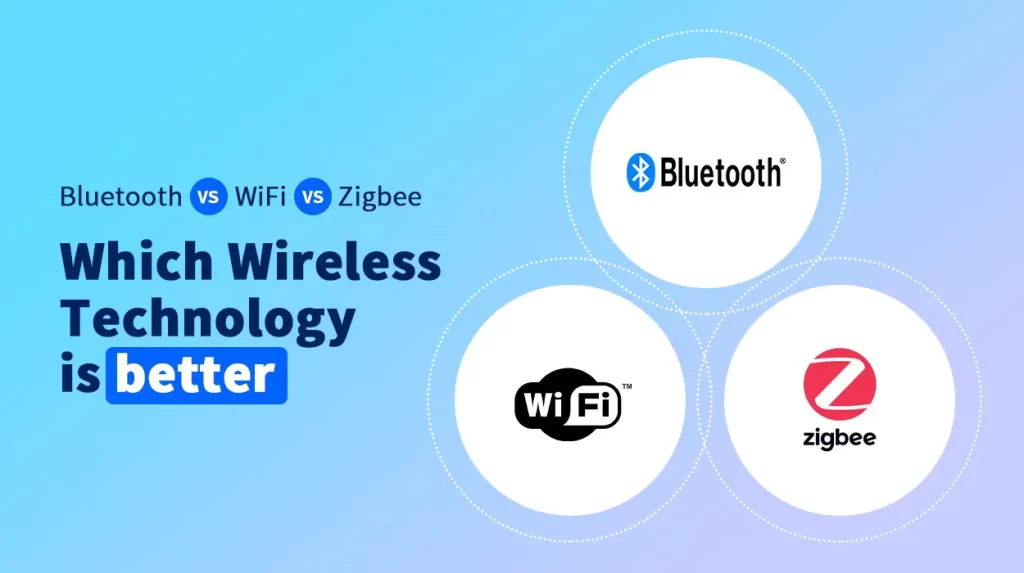
Comparison between Zigbee and WiFi, Bluetooth, and Z-wave.
End-user analysis
Residential users dominate the smart home hardware market due to the growing demand for convenience and advanced home management solutions.
The residential segment is the largest end-user in the smart home hardware market as more and more homeowners are adopting smart home technologies to improve their living environment. Smart home systems’ benefits drive the demand in this segment, including energy efficiency, security, convenience, and comfort.
Smart home devices allow residential users to automate routine tasks, such as adjusting lighting and temperature or managing security systems, thereby improving quality of life and freeing time for other activities.
Integration of smart devices through user-friendly interfaces and voice-controlled assistants has accelerated adoption rates by making the technology more accessible to non-technical users. Additionally, the increasing integration of smart home technology with renewable energy solutions, such as solar energy systems
Commercial users also contribute significantly to the market growth by adopting smart home technologies to improve energy management, security, and operational efficiency in office buildings, hotels, and other commercial properties.
The commercial sector benefits from the scalability and customizability of smart home technology, enabling businesses to tailor solutions to their specific needs and maximize their investment in intelligent infrastructure.
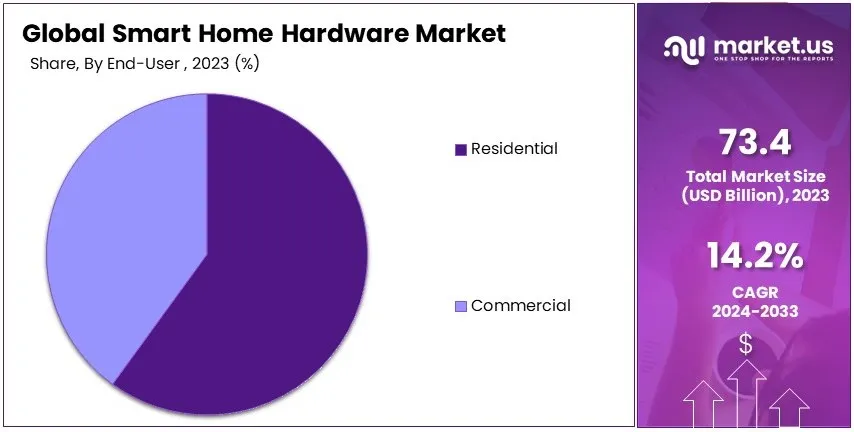
Global Smart Home Hardware Market End User Market Share
Key market segments
Product Type
1.Controlling and connecting equipment
Lighting control
- smart hubs and controllers
- lighting control
- smart light
- relays and switches
- occupancy sensors
- dimmer
Recreational equipment
- smart TV
- streaming device
- smart speaker
2.Smart home appliance
HVAC Heating, ventilation and air conditioning
- smart thermostat
- transducers
- smart vent
- other than
Intelligent Kitchen Appliances
- smart refrigerator
- smart dishwasher
- intelligent cookware and stoves
- smart oven
3.Security and surveillance equipment
- security camera
- walkie-talkie
- smart lock
- Motion Sensors
- Door/Window Sensors
Skill
- Wi-Fi
- Bluetooth
- Zigbee
- Z-Wave
- Other (RFID, NFC)
End User
- speculative activities
- trade
Development drivers
Growing Consumer Demand and Growth in Security Systems Drive Market Growth
Adopting Internet of Things (IoT) technology is the primary driver for the smart home hardware market. IoT supports seamless integration between devices and provides enhanced control and automation to homeowners. Growing consumer demand for home automation further supports the market growth.
The growth of smart home security systems is also playing a vital role in the market. Consumers prioritize security, which has led to the increasing adoption of connected cameras, alarms, and smart locks. These devices provide real-time monitoring and control, increasing the appeal of smart homes.
Advancements in artificial intelligence and voice control technologies have contributed significantly to the market expansion. Smart assistants such as Alexa and Google Assistant have made device management more intuitive and user-friendly. With the help of AI-driven features, consumers can enjoy a personalized experience which encourages the adoption of smart home hardware.
These factors collectively drive the smart home hardware market by enhancing product features and aligning with changing consumer preferences. The continuous growth of connected devices and increasing focus on personalized living spaces further support the market expansion.
Restraint
Privacy concerns and limited interoperability restrain market growth
High initial installation costs are a significant restraining factor in the smart home hardware market. The cost of purchasing and installing smart devices can be prohibitive for many consumers, especially in developing regions. This limits broader market penetration.
Privacy and security concerns have also hindered growth. Consumers are wary of data breaches, unauthorized access, and the potential misuse of personal information collected by smart devices. Such concerns can reduce consumer trust and slow adoption rates.
Limited interoperability between devices is another constraint. Consumers often encounter difficulties integrating devices from different manufacturers, leading to compatibility issues. This lack of seamless connectivity diminishes the appeal of smart home solutions.
Complex setup and maintenance requirements further challenge the market. Consumers prefer plug-and-play devices, but the need for technical expertise in the installation and troubleshooting process may deter potential buyers.
Development opportunities
Integration with renewable systems and affordable solutions offers opportunities
Expansion of emerging markets offers tremendous growth opportunities for smart home hardware. Increasing disposable incomes and greater awareness of smart technologies drive demand in these regions. Companies focusing on local partnerships and customized products can exploit this growth.
Integration with renewable energy systems is another promising opportunity. Consumers are looking for sustainable solutions, and combining smart home technology with solar panels and energy-efficient appliances fits into this trend.
The development of affordable smart home solutions can expand smart home hardware market reach. Affordable devices make smart home technology available to a broader audience, especially in price-sensitive markets. This focus on affordability can significantly increase market penetration.
Partnerships with real estate developers also offer growth potential. Integrating smart home hardware into new residential projects can drive volume sales and promote early adoption by homeowners.
Challenge
Intense Competition Regulatory Compliance Pose Challenges to Market Growth
Rapid obsolescence of technology is the major challenge faced by the smart home hardware market. As new features and devices emerge, existing products become obsolete quickly. This shorter lifecycle increases manufacturers’ costs and discourages consumers from long-term investments.
Intense market competition can also affect growth. Numerous players vied for market share, leading to aggressive pricing strategies and product differentiation efforts. This competition can limit profit margins and put pressure on smaller manufacturers.
Regulatory compliance and standards add to the complexity of the market. Organizations must comply with various regulations regarding data privacy, device security, and energy efficiency. Compliance efforts are resource-intensive, impacting production time and costs.
Supply chain vulnerabilities, including component availability disruptions, further challenge the market. Procurement and production delays may affect the timely release of products, thereby reducing market competitiveness.
Growth factor
Interface innovation and increasing lease adoption are growth factors
Several factors are contributing to the growth of the smart home hardware market. Increasing focus on energy efficiency is the primary driver, with consumers seeking devices that optimize energy usage and reduce costs. Energy-efficient solutions are in line with the goals of global sustainable development, making them more attractive to consumers.
Innovation in user-friendly interfaces is another growth factor. Devices that offer intuitive controls and seamless interaction enhance the consumer experience and encourage adoption. User-centered design is becoming a key differentiator in the market.
The increasing adoption of smart home solutions in rental properties drives growth. Landlords and property managers are integrating smart technologies to attract tenants and improve property management. This trend broadens the market base and supports continued demand.
Enhanced connectivity and networking solutions are further driving the market growth. Advancements in Wi-Fi and mesh networking have improved the performance and reliability of devices, making the smart home more efficient and attractive.
Emerging trend
Demand for wellness solutions subscription models are the latest trend factor.
Sustainability is a critical trend in the smart home hardware market. Consumers are increasingly seeking devices made from eco-friendly materials, driving the demand for sustainable smart home products. This trend is in line with global efforts to reduce environmental impact.
The demand for smart health monitoring solutions is another trend shaping the smart home hardware market. Devices such as smart thermometers, air quality monitors, and fitness trackers are becoming integral to the smart home. These health-focused devices cater to the growing consumer interest in wellness and preventive care.
The expansion of subscription-based models is also trending. Consumers opt for subscription plans offering regular updates, maintenance, and advanced features. This model fosters consumer loyalty and provides a stable revenue stream for manufacturers.
The growing popularity of multi-functional device integration is further driving the market. Consumers prefer devices with multiple functions, such as smart speakers with integrated virtual assistants and home automation controls.
Regional analysis
North America dominated the market with 37.9% market share.
North America led the smart home hardware market with a 37.9% share, totalling $27.82 billion. This dominance is driven by high disposable income, advanced infrastructure, and strong consumer interest in smart home technology. Rapid technological advancements and the presence of major technology companies in the region support the widespread adoption of smart home devices.
The North American smart home hardware market is characterized by high internet penetration, growing demand for energy-efficient solutions, and extensive use of IoT devices. The presence of key players and substantial investments in research and development further propel the market growth. The region’s high focus on security and automation is also driving the demand for advanced smart home hardware.
North America’s influence on the smart home hardware market is expected to remain strong with the adoption of AI-driven solutions and innovative city initiatives. With continued innovation, the region will likely maintain its leadership position and expand its market share by developing new products and enhancing connectivity.
- Europe: Europe holds a significant share of the smart home hardware market, driven by high consumer awareness and government incentives for energy-efficient devices. The region focuses on integrating sustainable technologies into smart homes.
- Asia-Pacific: The smart home hardware market is growing and is driven by urbanization, rising income levels, and technology adoption. Countries such as China and Japan are major contributors to promoting smart home innovation.
- Middle East and Africa: The smart home hardware market in the Middle East and Africa is emerging, supported by innovative city projects and increased internet penetration. The region’s focus on luxury smart solutions is driving growth.
- Latin America: Latin America is gradually embracing smart home hardware, driven by increased awareness and digital transformation. The region is increasingly adopting energy management and security-focused devices.
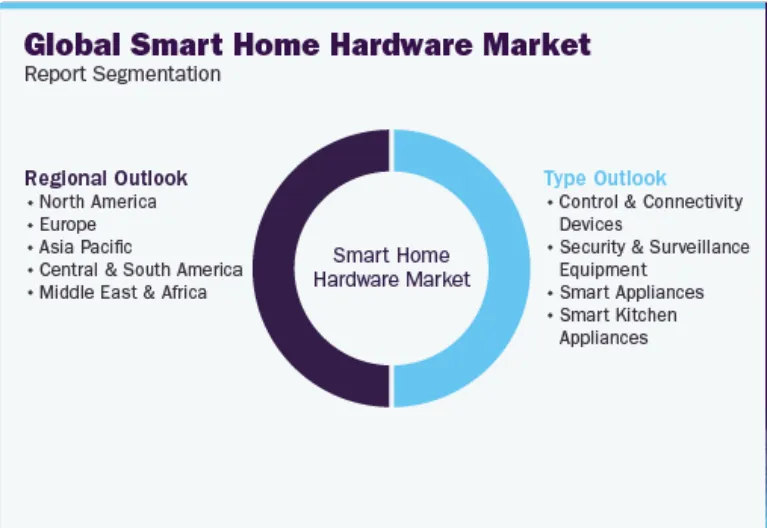
Analysis of key smart home hardware market players
The smart home hardware market is highly competitive, with leading companies focusing on innovation, connectivity and intelligent technologies. The global mainstream smart home hardware market players mainly include the following categories of companies, especially concentrated in Europe, the United States and China:
1.Large technology companies
Amazon
- Representative products: Echo series smart speakers, Alexa voice assistant
- Solution: Interconnect with various smart home devices through Alexa to support the control of lighting, security, temperature control and other functions to form an ecosystem.
- Representative products: Google Nest series (e.g. Nest Hub, Nest Thermostat)
- Solution: provide smart home control via Google Assistant, compatible with multiple brands of devices and support automated scene setting.
Apple
- Representative products: HomePod, HomeKit
- SOLUTION: Provide secure smart home control through HomeKit, emphasizing user privacy and data security.
2.Home appliance manufacturer
Samsung
- Representative products: SmartThings platform, smart appliances (refrigerators, washing machines, etc.)
- Solution: Centralized management and automation of home devices by interconnecting them with multiple devices through SmartThings.
LG
- Representative product: LG ThinQ
- Solution: Provide smart appliance control and monitoring, emphasizing energy efficiency and user experience.
3.Security company
Alpha (Arlo)
- Representative products: Wireless cameras and security systems
- Solution: Provide convenient home security monitoring with support for cloud storage and smart notifications.
Fluorite (EZVIZ)
- Representative products: Intelligent surveillance camera
- Solution: Provide easy installation and smart monitoring with a focus on cost-effectiveness.
4.Local Chinese company
Xiaomi
- Representative products: Mijia series of smart devices (e.g., smart speakers, light bulbs, cameras)
- Solution: Device interconnection and innovative scene setting through Mi Home App with an extensive ecosystem.
Huawei
- Representative products: Huawei smart home products (e.g. smart speakers, cameras)
- Solution: Provide device management through the Huawei Smart Life App, emphasizing security and privacy protection.
Tmall Genie (Alibaba)
- Representative product: Tmall Elf smart speaker
- Solution: Take voice assistant as the core, connect a variety of smart devices and build a smart home ecosystem.
5. Emerging brands
Ecobee
- Representative product: Ecobee smart thermostat
- Solution: Provide intelligent temperature control solution with voice control and energy saving function and support connection with other smart home devices.
Ring
- Product: Ring Video Doorbell
- Solution: Provide smart doorbells and security cameras, focusing on home security. Users can monitor visitors in real-time via cell phone.
August
- Representative product: August Smart Lock
- Solution: Provide smart door locks that support remote control and temporary access rights to enhance home security and convenience.
Tuya Smart
- Representative products: a variety of smart home devices and platforms
- Solution: Provide an open platform to support the interconnection of smart devices of multiple brands, focusing on developer ecology.
Sailingsi (SLS Smart)
- Representative products: smart home products (e.g. smart switches, smart gateways, etc.)
- Solution: Provide comprehensive smart home solutions that emphasize health and energy efficiency.
These market players are driving the development of smart homes through different products and solutions. While European and American companies usually have a strong advantage in technology and user experience, Chinese companies rapidly capture the market with their prices and the breadth of their ecosystems. With the advancement of IoT and AI technologies, the smart home hardware market will continue to grow, and competition among companies will become more intense.


